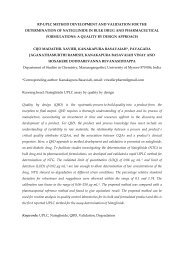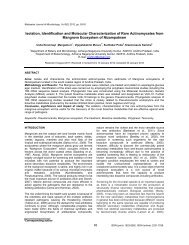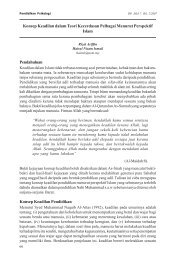"Acceptability" in the Translation into Malay of Rihlat Ibn ... - USM
"Acceptability" in the Translation into Malay of Rihlat Ibn ... - USM
"Acceptability" in the Translation into Malay of Rihlat Ibn ... - USM
Create successful ePaper yourself
Turn your PDF publications into a flip-book with our unique Google optimized e-Paper software.
"Acceptability" <strong>in</strong> <strong>the</strong> <strong>Translation</strong> <strong>of</strong> <strong>Rihlat</strong> <strong>Ibn</strong> Battutah 17<br />
formal culture <strong>of</strong> religious items. One possible reason is that religious items are<br />
sensitive items that do not <strong>of</strong>fer much room for generalisation. Those items have<br />
to be used and understood as <strong>the</strong>y are. On <strong>the</strong> o<strong>the</strong>r hand, food and dr<strong>in</strong>k, and<br />
cloth<strong>in</strong>g items are non-sensitive items and <strong>the</strong>refore can be <strong>in</strong>terpreted <strong>in</strong> many<br />
ways <strong>in</strong>clud<strong>in</strong>g by generalisation.<br />
Conclusion<br />
Acceptability is vital for some purposes <strong>of</strong> translation, <strong>in</strong> order to conform to <strong>the</strong><br />
stylistic features <strong>of</strong> <strong>the</strong> TL. This norm confirms <strong>the</strong> strategy <strong>of</strong> domestication<br />
where it <strong>in</strong>volves <strong>the</strong> recognisable and familiar text and as a result br<strong>in</strong>gs <strong>the</strong><br />
foreign culture closer to that <strong>of</strong> <strong>the</strong> readers <strong>of</strong> <strong>the</strong> TL. The concept <strong>of</strong><br />
acceptability can be achieved by implement<strong>in</strong>g some approaches and strategies <strong>in</strong><br />
translation. In deal<strong>in</strong>g with <strong>the</strong> translation <strong>of</strong> <strong>the</strong> Arabic-<strong>Malay</strong> language pair,<br />
several approaches <strong>of</strong> acceptability should be taken <strong>in</strong>to account:<br />
Notes<br />
i. The application <strong>of</strong> standard borrow<strong>in</strong>gs.<br />
ii. The application <strong>of</strong> nativised borrow<strong>in</strong>gs.<br />
iii. The application <strong>of</strong> explicitation.<br />
iv. The comb<strong>in</strong>ation <strong>of</strong> borrow<strong>in</strong>g with explicitation.<br />
v. The application <strong>of</strong> a functional equivalent through literal<br />
translation.<br />
vi. The allocation <strong>of</strong> an established and well-known equivalent<br />
through literal translation.<br />
vii. The application <strong>of</strong> generalisation.<br />
1. Munday (2008, 58) stresses that this concept is different from <strong>the</strong> concept <strong>of</strong> equivalence<br />
which is more common <strong>in</strong> <strong>the</strong>oretical use.<br />
Bibliography<br />
Campbell, S. 2007. Indonesian/<strong>Malay</strong>. In Encyclopedia <strong>of</strong> Arabic language and<br />
l<strong>in</strong>guistics. ed. K. Versteegh. Leiden and Boston: Brill, 340–345.<br />
Dick<strong>in</strong>s, J., Hervey, S. and Higg<strong>in</strong>s, I. 2002. Th<strong>in</strong>k<strong>in</strong>g Arabic translation. London and<br />
New York: Routledge.<br />
Genette, G 1997. Paratext: Thresholds <strong>of</strong> <strong>in</strong>terpretation. Cambridge, NY: Cambridge<br />
University Press.<br />
Hall, E.T. 1959/1990. The silent language. New York: Anchor Books.




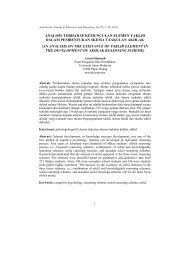
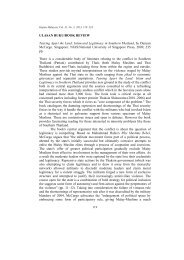

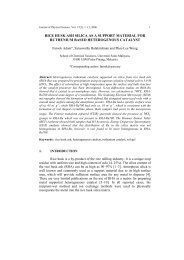

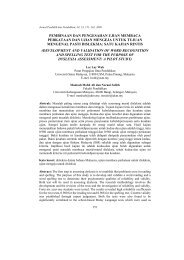
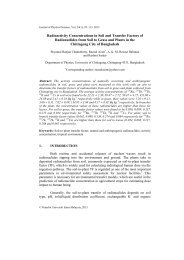
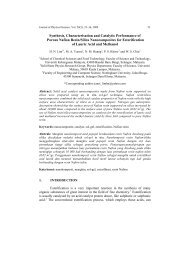

![KTT 111 – Inorganic Chemistry I [Kimia Takorganik I] - USM](https://img.yumpu.com/12405642/1/184x260/ktt-111-inorganic-chemistry-i-kimia-takorganik-i-usm.jpg?quality=85)
